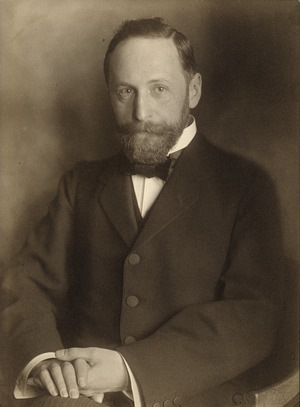Richard Willstätter facts for kids
Quick facts for kids
Richard Willstätter
|
|
|---|---|
 |
|
| Born |
Richard Martin Willstätter
13 August 1872 |
| Died | 3 August 1942 (aged 69) |
| Nationality | German |
| Alma mater | University of Munich |
| Known for | Organic chemistry |
| Spouse(s) | Sophie Leser (1903–1908; her death; 2 children) |
| Awards | Nobel Prize for Chemistry (1915) Faraday Lectureship Prize (1927) Davy Medal (1932) Willard Gibbs Award (1933) Fellow of the Royal Society |
| Scientific career | |
| Fields | Physical chemistry |
| Institutions | University of Munich ETH Zürich University of Berlin Kaiser Wilhelm Institute |
| Doctoral advisor | Alfred Einhorn, Adolf von Baeyer |
| Doctoral students | Jean Piccard |
Richard Martin Willstätter (born August 13, 1872 – died August 3, 1942) was a German chemist. He studied the colors found in plants, like chlorophyll. His work helped him win the 1915 Nobel Prize for Chemistry. Willstätter also helped develop paper chromatography, a way to separate different chemicals.
Contents
Early Life and Education
Richard Willstätter was born in Karlsruhe, Germany. His family was Jewish. His father, Maxwell Willstätter, was a textile merchant.
Richard went to school in Karlsruhe. Later, his family moved to Nuremberg, and he attended the Technical School there. When he was 18, he started studying science at the University of Munich. He stayed there for 15 years.
He studied chemistry and earned his doctorate degree in 1894. After that, he became a teacher at the university. He researched different chemicals called alkaloids and even made some of them himself. In 1896, he became a lecturer, and in 1902, he became a special kind of professor.
Research on Plant Colors
In 1905, Willstätter moved to ETH Zürich to become a professor. There, he started studying chlorophyll, the green color in plants. He figured out its basic chemical makeup.
In 1912, he became a chemistry professor at the University of Berlin. He also became the director of the Kaiser Wilhelm Institute for Chemistry. In Berlin, he continued to study the colors in flowers and fruits. He discovered that chlorophyll was actually a mix of two different compounds: chlorophyll a and chlorophyll b.
Work During World War I
During World War I, his friend Fritz Haber asked him to help with poison gases. Willstätter refused to work on making poisons. Instead, he agreed to work on ways to protect people from them.
He and his team created a special three-layer filter. This filter could absorb all the enemy's gases. By 1917, 30 million of these filters were made. Willstätter received an award for his important work.
Later Career and Retirement
In 1916, Willstätter returned to Munich. He took over from his old teacher, Adolf von Baeyer. In the 1920s, Willstätter studied how enzymes work. He showed that enzymes are chemical substances, not living organisms. However, he never believed that enzymes were proteins.
In 1924, Willstätter decided to retire early. He did this to protest against the unfair treatment of Jewish people at that time. Even though his colleagues and students wanted him to stay, he stuck to his decision. He continued to live in Munich. He refused many job offers from other places. He only did research by having assistants call him with their results.
Life in Switzerland
Willstätter stayed in Germany until 1939. Then, he moved to Switzerland. He spent his last three years in Muralto, near Locarno. During this time, he wrote his autobiography, which is the story of his life. He passed away in 1942 from a heart attack.
His autobiography, called Aus meinem Leben (From My Life), was published in German in 1949. It was translated into English in 1965.
Family
In 1903, Richard Willstätter married Sophie Leser. She passed away in 1908. They had two children together.
Honours
In 1965, the school he attended in Nuremberg was named Willstätter-Gymnasium in his honor.
See also
 In Spanish: Richard Willstätter para niños
In Spanish: Richard Willstätter para niños
- List of Jewish Nobel laureates

